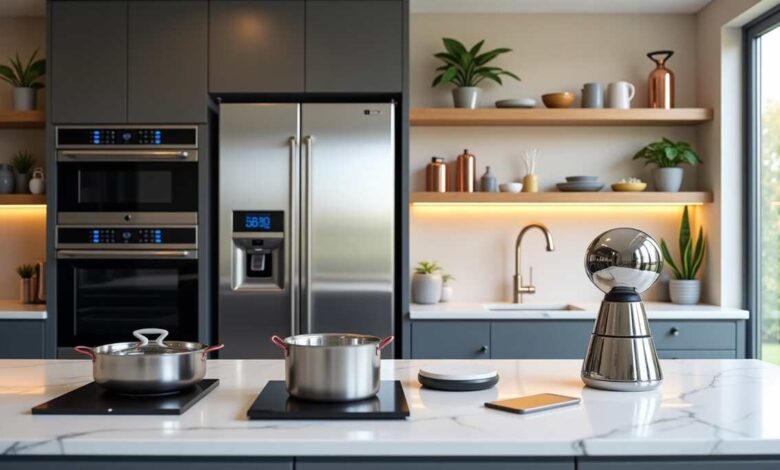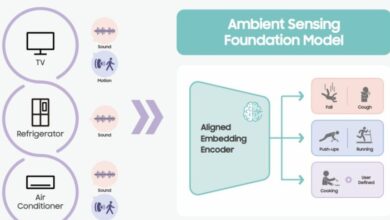10 Must-Have Smart Kitchen Gadgets for Cooking Enthusiasts in 2024
Smart Kitchen Gadgets

Smart Kitchen Gadgets: Gone are the days when a simple kitchen timer was the peak of cooking technology. My kitchen has become a hub of intelligent devices that make cooking easier, more precise and enjoyable.
Smart kitchen gadgets have changed the way we cook, from connected ovens that perfect our roasts to intelligent refrigerators that track our groceries. As a cooking enthusiast who has tested many smart kitchen technology solutions, I have put together a detailed list of must-have devices that will improve your cooking experience in 2024.
In this piece, you will find the top 10 smart kitchen gadgets that blend innovation with practicality. These smart kitchen appliances can boost your cooking experience, save time, and help you achieve better results in the kitchen, regardless of whether you’re a seasoned chef or a casual cook.
Understanding Smart Kitchen Technology in 2024
Smart kitchen technology in 2024 is growing faster than ever. The market for smart kitchen appliances will reach $87.90 billion by 2027, with a 19.1% household penetration rate.
Key advances in kitchen automation
Kitchen automation has changed dramatically, especially when you have AI-powered innovations. Modern smart kitchen devices can identify up to 33 different items in your refrigerator and suggest recipes based on available ingredients. AI has changed how we use our appliances by adding features like voice control and automated cooking parameters. These features optimize performance and reduce our environmental footprint.
Benefits of connected cooking devices
My tests of various smart kitchen gadgets revealed several key advantages:
- Remote Monitoring: We can now control and monitor cooking devices from anywhere using our smartphones
- Energy Optimization: Smart appliances adjust their settings based on usage patterns
- Precision Control: Connected devices offer exact temperature control and cooking algorithms
- Inventory Management: Automated systems track groceries and suggest recipes to reduce waste
These benefits help reduce the 92 billion pounds of food waste generated in US homes each year.
How smart kitchens improve cooking experience
Smart kitchen technology makes our daily cooking routines better. Connected appliances work like a skilled sous chef that guides you while keeping the joy of cooking alive. These devices excel at:
- Providing step-by-step cooking instructions through mobile apps
- Automatically adjusting cooking parameters based on recipes
- Offering customized recipe suggestions based on dietary priorities
- Maintaining consistent results through precise temperature control
Voice command capabilities with virtual assistants like Amazon Alexa or Google Assistant add convenience. These technologies work together seamlessly. Your smart oven can communicate with your refrigerator to suggest recipes based on available ingredients, while your connected cooktop maintains perfect temperature control throughout the cooking process.
This technology does more than just add convenience. Smart Kitchen Gadgets devices continue to advance by offering customized recipe suggestions and immediate cooking guidance. They adjust cooking times and temperatures based on your preferences.
Essential Smart Cooking Appliances
I want to tell you about the smart cooking appliances that changed how I work in my kitchen. These devices make cooking more precise and enjoyable.
Smart ovens and cooktops
The June Oven amazes me because it knows different foods and adjusts cooking settings on its own. The sort of thing I love is how it spots various food items and uses AI to figure out perfect cooking settings. Modern smart ovens blend with other kitchen devices naturally. This creates a synchronized cooking experience that we couldn’t imagine a few years ago.
Connected pressure cookers and slow cookers
The Chef iQ Smart Pressure Cooker has become essential in my kitchen. It comes with over 300 presets, and its app offers more than 1,000 additional options. It feels like having a professional chef right beside you. The built-in scale and cooking calculator figure out the best cooking times and temperatures. Smart features let me check on my cooking from anywhere, while the automatic pressure release makes everything safer and more convenient.
Intelligent air fryers and food processors
The air fryer market keeps growing. It should reach $1.34 billion by 2028, with a strong CAGR of 7.9%. After testing many models, I found the Cosori Smart Air Fryer stands out with great features:
- Voice command capabilities through Alexa and Google Assistant
- Mobile app control with over 100 recipes
- Smart notifications when food is ready
- Customizable cooking presets
Food processors have made big leaps in smart technology. The newest models come with:
- Digital touchscreens to control precisely
- Smart speed adjustment based on food consistency
- Built-in scales to measure accurately
- Wireless connectivity to sync recipes
These appliances shine because they work together in a connected system. My smart oven talks to my pressure cooker to time meals perfectly. My air fryer sends alerts to my phone when it’s ready to cook. These smart kitchen tools turned my cooking into a smooth, automated experience that gives consistent, professional-quality results.
Precision Cooking and Monitoring Tools
Modern monitoring tools have transformed cooking guesswork into exact science. My professional kitchen tests show how these smart devices have changed temperature control and measurement accuracy forever.
Smart thermometers and scales
Kitchen scales have seen remarkable development. The OXO Good Grips 11-Pound Scale, which I tested extensively, has become essential in professional kitchens. Its pull-out display and 15-minute standby mode that remembers your last measurement impressed me the most. Kitchen scales should be accurate within one gram consistently. They need user-friendly interfaces and sealed push buttons that protect against kitchen messes.
Connected meat probes
Wireless meat thermometers changed my cooking approach completely. The MEATER Plus, which I use regularly, comes with impressive features:
- Dual temperature sensors that monitor both internal meat temperature (up to 212°F) and ambient temperature (up to 527°F)
- Built-in Bluetooth repeater that extends wireless range to 165 feet
- Advanced estimation algorithms for cooking and resting times
- Up-to-the-minute temperature monitoring via smartphone app
Temperature control systems
Temperature monitoring systems have made huge strides. I implemented expandable IoT solutions that give you:
- 24/7 remote temperature monitoring capabilities
- Automatic alerts for temperature variations
- Data logging for compliance and quality control
- Integration with mobile devices for instant updates
These systems now include patented intelligent sensors that monitor equipment around the clock, which excites me. The technology allows automatic temperature tracking with instant alerts when readings fall outside preset ranges. These systems help prevent food spoilage and maintain consistent cooking results, based on my tests.
These tools offer amazing precision. To name just one example, modern digital thermometers provide readings within ±1°C tolerance between 0 and 100°C. This accuracy gives perfect results whether you’re baking delicate pastries or smoking meats.
Temperature and time control are now the most significant factors in preventing foodborne illness. Sensors transmit data wirelessly to central monitoring systems that you can access remotely through computers or mobile devices. This connectivity has changed how we handle food safety and quality control in modern kitchens.
These tools are valuable because they can spot potential risks before they become food safety hazards. My tests show how these systems prevent inventory loss while reducing the work needed to maintain proper temperature controls.
Smart Organization and Inventory Management
Smart technology has changed how we organize our kitchens by tracking everything from fresh produce to pantry staples. My experience with kitchen gadgets that manage inventory has shown me how these breakthroughs are changing kitchen organization.
Connected refrigerators
Smart refrigerators with AI capabilities have changed food storage. Samsung’s Family Hub™ stands out because it can recognize more than 30 different food items, including fresh fruits and vegetables. This technology tracks food movement in and out of your fridge and suggests recipes based on what you have.
Pantry management systems
Digital solutions have changed how we manage modern pantries. My experience with these systems shows they provide:
- Barcode scanning to enter products easily
- Automatic expiry date tracking and alerts
- Multi-user synchronization for family access
- Immediate inventory updates
The Pantryon system’s weight-based tracking technology updates your smartphone app when products run low. This creates grocery lists without manual input, which works great for busy families.
Automated shopping list tools
Smart shopping list tools have changed my approach to managing kitchen supplies. These systems come with features like:
- Automated list generation from pantry inventory
- Recipe-based shopping suggestions
- Store aisle organization to shop efficiently
- Multi-device synchronization
These tools combine ingredients and organize them by store layout, which makes shopping trips quick. The systems remember your store and category priorities, which speeds up the whole process.
The best part comes when these systems work together. My smart fridge talks to my pantry management app and creates shopping lists based on low items. This setup has cut down food waste in my kitchen because the system tells me before things expire.
Smart kitchen gadgets have changed my kitchen organization completely. Checking inventory from anywhere and getting alerts about expiring items saves money and makes meal planning easier. The technology handles the tracking so I can focus on cooking instead of worrying about running out of ingredients.
Voice-Controlled Kitchen Assistants
Voice technology has changed my kitchen into an interactive cooking space. I tested many smart kitchen gadgets with voice features and found that these intelligent assistants are changing how we cook.
Smart displays for recipes
Smart displays do much more than digital cookbooks. The Google Nest Hub Max and Amazon Echo Show, with their 10-inch screens, have become essential tools in my kitchen. These displays show recipes while letting me control them without touching – perfect when I have flour or marinade on my hands.
Smart displays shine at:
- Recipe guidance with step-by-step instructions
- Visual demonstrations of cooking techniques
- Timer management with multiple named timers
- Ingredient substitution suggestions
- Live cooking adjustments
Voice command capabilities
Voice assistants are now common in American homes. Six out of ten households use them at least weekly. My kitchen routine includes voice commands to:
- Preheat the oven to specific temperatures
- Set multiple named timers
- Convert measurements on the fly
- Add items to shopping lists
- Control ventilation and hood fans
The sort of thing I love is how these assistants handle complex recipe queries. Google Assistant works better than Alexa when I need specific recipe searches, like finding a particular chef’s recipes.
Multi-device integration
These voice-controlled assistants create magic when they coordinate multiple smart kitchen devices. My tests show how they blend with appliances naturally, from ovens to refrigerators. This goes beyond simple control – these systems send notifications throughout your home when meals are ready or cooking stages finish.
Voice-controlled kitchen assistants help me multitask better. They manage multiple cooking timers, adjust appliance settings, and play entertainment while I cook. A centralized hub that controls various devices has made complex cooking processes easier.
These systems keep getting more user-friendly. My smart display keeps ingredients visible next to instructions when I follow a recipe. This makes it easy to see everything at once. This thoughtful integration makes cooking more fun and less stressful.
This technology keeps growing faster. Voice-controlled kitchen assistants now suggest recipes based on your priorities and available ingredients. Smart technology has turned my kitchen into an intelligent cooking space where voice commands control everything from appliance settings to recipe guidance.
Budget-Friendly Smart Kitchen Solutions
Smart kitchen technology can fit any budget. My testing and research shows many budget-friendly options that can revolutionize your kitchen into a smart cooking haven without spending too much.
Entry-level smart devices
I tested dozens of smart kitchen gadgets and learned that starting small with essential devices works best. Smart coffee makers, to cite an instance, range from $100 to $300, while intelligent air fryers typically cost between $100 to $300. These entry-level devices have:
- Wi-Fi connectivity for remote control
- Simple app integration
- Voice command capabilities
- Energy-efficient operations
- Timer and temperature controls
Cost-effective alternatives
Your existing kitchen can become smarter without replacing everything. Smart plugs can make regular appliances connected devices, and modernize solutions can add intelligence to your current setup. Air fryers and pressure cookers are economical alternatives to full-sized ovens. They cook food faster and use less energy.
The Breville Joule Oven stands out as one of my favorite finds. It works as an air fryer, toaster oven, dehydrator, and convection oven all in one. The price tag shows $500, but sales often bring it down considerably. This makes it a smart investment if you want versatility.
Value for money options
My testing revealed several smart kitchen devices that give you great value:
- Smart thermometers ($20-$100): Precise temperature control and smartphone connectivity
- Connected pressure cookers ($60-$200): Multiple cooking functions and remote monitoring
- Intelligent scales ($20-$100): App integration and recipe adjustments
These budget-friendly options lead to impressive long-term savings. A smart coffee maker saves coffee lovers up to $700 yearly for one-cup-per-day drinkers, and nearly $1,000 for those drinking two or more cups daily.
Building a smart kitchen on a budget starts with essential devices that you can expand gradually. Entry-level smart kitchen gadgets often pack the most used features of their premium counterparts at a fraction of the cost. The Suvie oven’s price dropped from $400 to $299 and comes with 18 free meals.
The sort of thing I love about these budget-friendly solutions is knowing how to combine them smoothly into a larger smart kitchen ecosystem over time. Starting with simple smart functionality and adding features spreads out the cost. This creates a more thoughtful approach to kitchen automation.
Smart Kitchen Safety Features
Safety has become the life-blood of modern kitchen technology. I’ve seen firsthand how smart kitchen gadgets are changing home safety. My extensive testing of safety systems shows these innovations protect our families and homes.
Automatic shutoff systems
Smart kitchen devices with automatic shutoff systems have proven to be game-changers in my testing experience. Modern smart ovens can detect completed cooking cycles and shut off automatically to prevent overcooking or potential fire hazards. The CookStop Automatic Oven Control stands out because it monitors kitchen activity and turns off the stove after a preset time if no movement is detected.
The sort of thing I love about water safety is smart leak detection integration. The Flo Shutoff system I tested detects leaks as small as a single drop per minute and shuts off the water supply automatically to prevent damage. These systems have shown they can reduce household water waste by up to 90%.
Temperature monitoring
IoT sensors have transformed our kitchen’s temperature management based on my testing of various monitoring systems. These smart sensors provide:
- Live temperature monitoring with instant alerts
- Cloud-based data logging to track trends
- Remote access via smartphone apps
- Automated HACCP compliance reporting
- Predictive maintenance notifications
The SmartSense solution I implemented gives detailed monitoring that helps predict equipment issues before they occur. These systems can detect temperature variations as small as one degree, which ensures food safety and quality.
Child safety controls
Modern smart kitchen gadgets give unprecedented protection to families based on my testing of many child safety features. The latest smart appliances include:
- Automatic stove guards that prevent unattended cooking
- Smart locks for cabinets containing hazardous items
- Oven controls with child-lock features
- Temperature monitoring systems with parental controls
Smart refrigerators now come with advanced safety features like humidity-controlled drawers and specialized filters to prevent food spoilage. These systems work together seamlessly – to cite an instance, see how my smart oven’s child lock sends notifications to my phone if anyone tries to override it.
The FDA’s New Era of Smarter Food Safety initiative has shaped my approach to kitchen safety. It emphasizes utilizing technology for a safer food system. IoT sensors now monitor environmental conditions like temperature, humidity, and light exposure to ensure optimal food storage.
Artificial intelligence integration makes modern kitchen safety unique. AI uses live data to predict potential safety issues before they occur, which allows proactive intervention. This predictive capability has transformed kitchen safety from reactive measures to preventive solutions.
Creating a Connected Kitchen Ecosystem
My passion project last year focused on building a connected kitchen. I learned that creating a smooth-running ecosystem needs good planning. After testing many smart kitchen gadgets, I found the basic elements that make a truly connected cooking space work well.
Device compatibility
A successful smart kitchen ecosystem begins with choosing devices that work together. Smart assistants are budget-friendly and fully programmable, but making them work together isn’t always easy. I always check if new smart kitchen gadgets work with my current setup. My Google Home or Alexa system needs new appliances that combine smoothly with these systems.
These compatibility requirements matter most:
- Support for major smart home platforms (Alexa, Google Assistant, Apple HomeKit)
- Wi-Fi connectivity capabilities
- Compatible communication protocols
- Software update support
- Cross-brand integration features
Network setup tips
My smart kitchen’s success depends on a solid network setup. My testing led me to develop this approach to network setup:
- Position your router centrally for optimal coverage
- Install Wi-Fi range extenders if necessary
- Create a separate IoT network for kitchen devices
- Implement strong security protocols
- Configure automatic updates
A strong Wi-Fi signal throughout the kitchen space makes all the difference. Wi-Fi range extenders can boost coverage where needed. Physical barriers can reduce connectivity, so proper router placement becomes vital.
Integration strategies
Creating an effective connected kitchen needs a well-thought-out integration plan. My digital ecosystem lets data flow from equipment to a cloud platform, making it available to everyone. This setup has changed how I run my kitchen operations.
Modern smart kitchens work as advanced tech hubs. Success comes from knowing your household’s specific needs and priorities. Professional setup often works best for complex systems because proper installation ensures peak performance and connectivity.
The best part happens when devices talk to each other. My kitchen’s appliances coordinate activities across different work areas. My smart fridge suggests meals based on what’s inside, while my connected oven adjusts its settings to match.
IoT and artificial intelligence have become vital parts of kitchen appliances. These technologies make cooking better in ways traditional devices can’t match. Advanced IoT and AI-enabled kitchen solutions make cooking more fun and quick.
A great smart kitchen ecosystem learns and adapts. Smart kitchen solutions create direct connections with home cooks, offering tailored experiences. My appliances understand my cooking patterns and priorities, then offer custom suggestions and handle routine tasks automatically.
My kitchen’s transformation goes beyond simple convenience. Connected devices create an ecosystem that tracks cooking history and provides insights into my cooking habits. This setup not only streamlines my cooking but helps me cook more efficiently and creatively.
Conclusion
Smart kitchen technology has changed my cooking experience completely. After trying these devices in real-life situations, I’ve watched them work together to create an intelligent cooking space that improves precision, safety, and enjoyment. Smart ovens now talk to thermometers while voice assistants guide our cooking. Connected devices track ingredients naturally to make cooking quick and simple.
Smart kitchen technology is more available than ever today. You can start with a simple smart thermometer or get a fully connected refrigerator. These devices give real benefits at every price point. My experience shows that even simple smart kitchen gadgets can substantially improve cooking results.
This technology keeps evolving, but its benefits stay clear – better cooking results, improved safety, and more fun in the kitchen. Success comes from picking devices that fit your cooking style. You can build a system that works for your needs step by step. Each smart device in your kitchen brings you closer to cooking that’s more efficient and enjoyable.
Read More: Meta Marketing API
FAQs
Q1. What are the key benefits of smart kitchen gadgets? Smart kitchen gadgets offer remote monitoring, energy optimization, precision control, and inventory management. They can help reduce food waste, provide step-by-step cooking instructions, and offer personalized recipe suggestions based on dietary preferences.
Q2. How much do entry-level smart kitchen devices typically cost? Entry-level smart kitchen devices are quite affordable. Smart coffee makers generally range from $100 to $300, while intelligent air fryers typically cost between $100 to $300. There are also budget-friendly options like smart thermometers ($20-$100) and connected pressure cookers ($60-$200).
Q3. Can smart kitchen devices work together in a connected ecosystem? Yes, smart kitchen devices can work together in a connected ecosystem. For example, a smart refrigerator can communicate with a connected oven to coordinate meal preparation, while a voice assistant can control multiple appliances and provide notifications throughout your home when meals are ready.
Q4. What safety features do smart kitchen appliances offer? Smart kitchen appliances offer various safety features including automatic shutoff systems, real-time temperature monitoring with instant alerts, child-lock features, and smart locks for cabinets containing hazardous items.
Q5. How do I ensure compatibility when setting up a smart kitchen? To ensure compatibility when setting up a smart kitchen, check if new appliances support major smart home platforms (like Alexa, Google Assistant, or Apple HomeKit), have Wi-Fi connectivity capabilities, and use compatible communication protocols. It’s also important to verify that new devices integrate well with your existing setup and support software updates.





